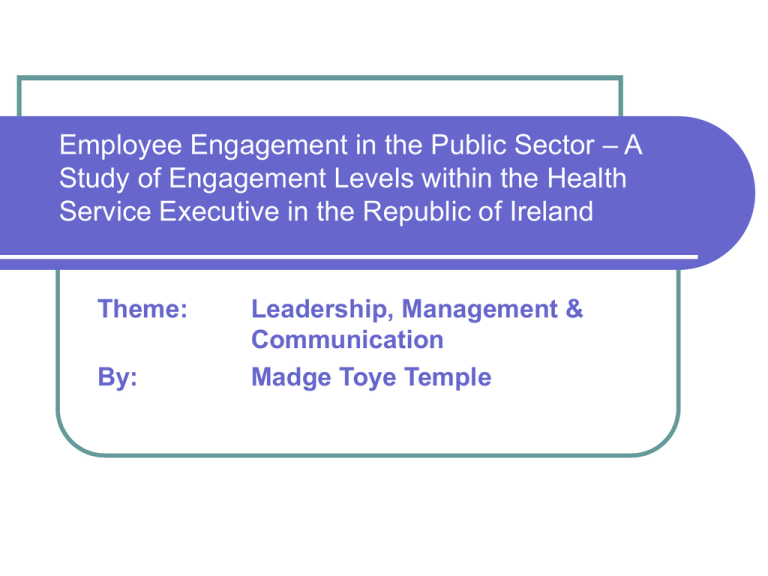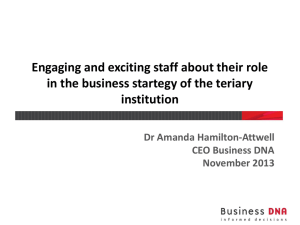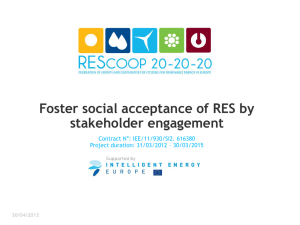Madge Toye Temple
advertisement

Employee Engagement in the Public Sector – A Study of Engagement Levels within the Health Service Executive in the Republic of Ireland Theme: By: Leadership, Management & Communication Madge Toye Temple What is Employee Engagement Employee Engagement is a combination of commitment to the organisation and its values and a willingness to help out colleagues (CIPD, 2011). Employee Engagement is much more than job satisfaction and motivation. Employee Engagement is a measurable degree of an employee’s positive or negative emotional attachment to their job, their colleagues and their organisation all of which profoundly influences their willingness to learn and perform at work. What does Employee Engagement mean to an Organisation Employee Engagement positively impacts on business outcomes such as: Employee satisfaction Safety Productivity Profitability Improves organisational performance (even in challenging economic times) Why Study Employee Engagement in the Health Service Executive Globally, the recession has dramatically altered the way employees view their work (Towers Watson, 2010). The public service is not exempt from the recession and economic downturn forcing organisation to change The Health Service Executive has experienced major change There are few studies of Employee Engagement in Ireland Objectives of the Study 1: To ascertain if there are any differences in the levels of Employee Engagement across the following variables: gender, age, contract agreement, working hours and duration of employment. 2: To ascertain if there are variances in Employee Engagement in the various job roles within the Health Service Executive. 3: To investigate the relationship between performance reviews and Employee Engagement. Method Study was based on ONE local health office within the HSE 4% of all employees completed the Utrecht Work Engagement Scale (UWES) achieving a response rate of 59%. UWES measures employee engagement by 3 constructs – vigour, dedication and absorption. Results of the Study Levels o f Emplo yee Engagement - H SE Percentage No. of Employees 60.00% 50.00% Very Low Engagement 40.00% Low Engagement Average Engagement 30.00% High Engagement Very High Engagement 20.00% 10.00% 0.00% E n g a g e me n t Results of the Study - Gender Gender and Low to High Employee Engagement 40 35 % of Employees 30 25 20 15 10 5 0 Male Females Low to Very Low Engagement High to Very High Engagement Results of the Study - Age Low to Very Low Employee Engagement High to Very High Employee Engagement 40.0 35.0 30.0 % of Employees 25.0 20.0 15.0 10.0 5.0 0.0 18-25 26-35 46-55 36-45 Age of Employees 56-65 Over 65 Results of the Study – Contracted Agreement Permanent / Temporary Status Employee Engagement 60 49 50 50 % 40 38 Permanent 30 Temporary 25 20 17 10 6 4 4 3 4 0 Very Low Engagement Low Engagement Average Engagement High Engagement Very High Engagement Results of the Study – Working Hours Work Agreement & Low to High Engagement Low to Very Low Engagement High to Very High Engagement 50.0 45.0 40.0 % of Employees 35.0 30.0 25.0 20.0 15.0 10.0 5.0 0.0 Reduced Hours Flexible Working Shift Work Job-Sharing Fixed Work Pattern Parental Leave Other Results of the Study – Duration of Employment % No. of Employees No. of Years Employed and Low to High Employee Engagement 50 40 30 Low / Very Low 20 High / Very High 10 0 Less than 1 year 1-5 years 6-10 years 11-15 years 16-20 years 21-25 years Years Employed Over 25 years Results of the Study – Job Roles Job Category and Low to High Employee Engagement Low to Very Low Engagement High to Very High Engagement 50 45 40 % of Employees 35 30 25 20 15 10 5 0 Allied Health & Social Care Management / Admin / ICT Medical & Dental Interns / SHO's / Registrars Nursing Patient & Client Care Support Result of the Study – Performance Review Have had a Performance Review and Employee Engagement Yes No 60 51 50 41 38 40 % 30 24 17 20 15 7 10 3 3 0 0 Very Low Engagement Low Engagement Average Engagement High Engagement Very High Engagement Key Findings of the Research 50% of employees are within the range of “average engagement” and experience engagement “a couple of times per month” with a mean engagement score of 3.91. A higher level of Employee Engagement exists in the organisation in comparison to similar international studies. There is no significant difference in the levels of Employee Engagement among the different groups within each of the variables of: “age”, “employment status”, “gender”, ”job category”, “work agreement”, “job category”, “duration of employment” and having a “performance review”. There exists a significant relationship between dedication and employment status with temporary employees indicating higher dedication than permanent employees There exists a significant relationship between dedication and having participated in a performance review, with participants who have had a performance review indicating a higher level of dedication than those employees who have not had a performance review. Recommendations Share the vision of the organisation with all employees Ensure all employees know their role in the organisation Recognise and appreciate commitment Leadership Listen to and respond to feedback Involve all employees











